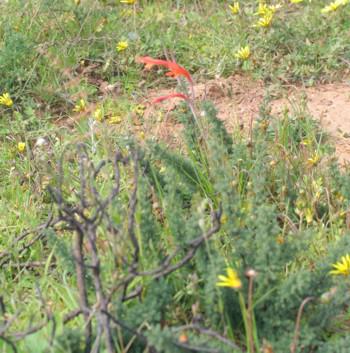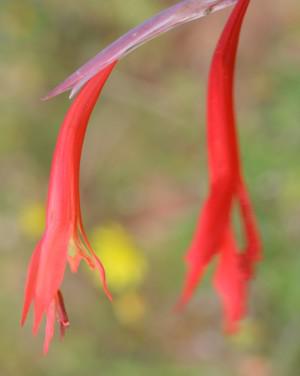Gladiolus vandermerwei
Gladiolus vandermerwei (L.Bolus) Goldblatt & M.P.de Vos
Family: Iridaceae
Common names: Overberg renosterveld gladiolus (Eng.); rooipypie (Afr.)
Introduction
Gladiolus vandermerwei is a highly threatened species, occurring in the Ruens Renosterveld areas of the eastern Overberg. This species has become a flagship species, highlighting the plight of one of the most threatened vegetation types in the world. This stunning plant co-occurs with a number of special plants in the Overberg and is a good indicator of this unique habitat.

Description
Description
Plants are 300–600 mm high, with globe-shaped corms that are 8–12 mm in diameter and have papery to membranous tunics. Leaves are 5 to 7, narrowly lanceolate to linear, mostly basal with a raised midrib. Stems are upright at the base and slightly curved towards to the top. Inflorescence is a spike that is lightly flexuose and usually has between 3–8 flowers per spike. Flowers are bright scarlet-red, with the lower tepals yellow in the lower half. The perianth tube is narrow and cylindric, gradually expanding towards the top. The ovary is oblong, 8 mm long. The seeds are irregularly ovate.
Conservation Status
Status
Gladiolus vandermerwei is red listed as Endangered (EN). It has lost more than 80% of its habitat, and the remaining populations are found on mostly small, fragmented, renosterveld remnants. The remaining populations are usually small in size with only a few plants in each area. They are mostly threatened by habitat loss due to agricultural development, overgrazing and irregular fire frequency. The CREW programme in partnership with the Overberg Lowlands Conservation Trust (http://overbergrenosterveld.org.za/) has been conducting surveys in the Overberg areas to find more populations of this species. Previously it was only known from four records between Napier and Swellendam and we have found four new populations of the species in the area. Due to the new data that the CREW programme has collected, the species might be down-listed to Vulnerable.

Distribution and habitat
Distribution description
This species has a very narrow distribution range; it occurs in the Lower Breede River Valley from the Bonnievale area down to Vermaaklikheid in the southwestern Cape. There are also records from the Bredasdorp and Swellendam area. It grows in stony, shale soil, in dry areas. It has also been collected on stony quarzitic outcrops, which is a very specialized habitat in the lower Breede River Valley.
Derivation of name and historical aspects
History
The specific epithet vandermerwei, is named in honour of J.S. van der Merwe, who collected the plants in 1928. He gave plants to P. Ross Frames who grew them in Cape Town and gave specimens to the Bolus Herbarium. Louisa Bolus recognized it as a new species and described it in 1933, first placing it in the genus Antholyza. After N.E. Brown revised the generic concepts, he transferred the species to the genus Homoglossum. In 1989, the species was placed in Gladiolus, by Goldblatt & De Vos.
Ecology
Ecology
Gladiolus vandermerwei is adapted for pollination by sunbirds, its bright red flowers and elongated perianth tube with the upper part wide and cylindric and containing a liberal amount of low sugar concentration nectar.
Uses
Use
There are no recorded cultural or medicinal uses for this plant, but it has good horticultural potential. The contrasting red and yellow flowers will be a lovely addition to any garden, and it has potential as a container plant due to its dainty features. Its main flowering time is late spring, from mid-September to early October.
Growing Gladiolus vandermerwei
Grow
There are very few records of this species in cultivation, but it has the potential to be a good feature plant to attract birds to a garden. Plants can be cultivated from seed and corms. Winter-growing bulbs require well-drained soil. Corms can be planted in autumn at a depth of between 2–5 cm depending on the size of the corms. Seeds must be sown in autumn and will germinate within three to six weeks. This plant is naturally suited to areas that are hot and dry. Corms must be lifted in summer and stored. Corms of winter growers are susceptible to mealy bug and fungal rotting. Flower buds are attacked by aphids
References
- Duncan, G. 2010. Grow bulbs. Kirstenbosch Gardening Series. South African National Biodiversity Institute, Cape Town.
- Goldblatt, P. & Manning, J. 1998. Gladiolus in southern Africa. Fernwood Press, Vlaeberg.
- Lewis, G.J., Obermeyer, A.A. & Barnard, T.T. 1972. Gladiolus: a revision of the South African species. Purnell & Sons, Cape Town.
- Raimondo, D., Von Staden, L., Foden, W., Victor, J.E., Helme, N.A., Turner, R.C., Kamundi, D.A. & Manyama, P.A. (eds). in press. Red List of South African plants. Strelitzia 25. South African National Biodiversity Institute, Pretoria.
Credits
Ismail Ebrahim
CREW
December 2014
Plant Attributes:
Plant Type: Bulb
SA Distribution: Western Cape
Soil type: Clay, Loam
Flowering season: Spring
PH: Acid
Flower colour: Yellow
Aspect: Full Sun
Gardening skill: Average
Special Features:
Horticultural zones










Rate this article
Article well written and informative
Rate this plant
Is this an interesting plant?
Login to add your Comment
Back to topNot registered yet? Click here to register.